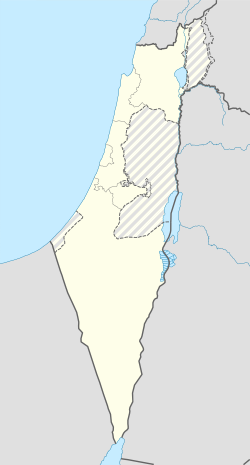Matzuva
Matzuva
מַצּוּבָה | |
|---|---|
| Hebrew transcription(s) | |
| • official | Mazzuva |
| • unofficial | Matzuba |
 | |
| Coordinates: 33°3′48″N 35°9′30″E / 33.06333°N 35.15833°E | |
| Country | |
| District | Northern |
| Council | Mateh Asher |
| Affiliation | Kibbutz Movement |
| Founded | 1940 |
| Founded by | German, Czechoslovak, and Austrian Jewish members of Maccabi Hatzair |
| Population (2023)[1] | 1,193 |
Matzuva (Hebrew: מַצּוּבָה), also known as Metzuba, is a kibbutz in the Western Galilee in northern Israel. Located to the south of the development town of Shlomi, it falls under the jurisdiction of Mateh Asher Regional Council. In 2023 it had a population of 1,193.[1]
Etymology
[edit]The settlement was named after the nearby Byzantine-period town of Pi-ha-Masuba, a place mentioned in the Tosefta (Shevi'it 4:8-ff.) and in the 3rd-century Mosaic of Rehob.[2] The ancient Christian town was thoroughly destroyed in 613 or 614, never to regain its former size and wealth, but the name survived throughout the Early Muslim, Crusader, and into the Mamluk period. The remains of Byzantine-era Pi Metzuba, whose location was known from previous surveys, were actually discovered in 2020 along the road connecting Shlomi and Hanita,[3] about two kilometers north of Matzuva.
The name is believed to have been derived from mṣwbh, a Semitic root, meaning 'pyramid' or 'pyramidal pile'.[4]
History
[edit]The process towards the founding of the kibbutz began with a group of immigrants from Germany, Czechoslovakia, and Austria, members of the Maccabi Hatzair youth movement, who came to Mandatory Palestine in 1934.[2] In 1937, the group underwent hakhshara in Degania Alef and built an agricultural settlement near Hadera. In 1939, the group moved to Hanita, where they were joined by other recent immigrants who had come to Palestine through the Youth Aliyah program via Aliyah Bet ships, and had undergone hakhshara in Kfar HaHoresh.
On 9 February 1940, the kibbutz was erected in its current location, and was named for the nearby ruins. In its early days, the kibbutz suffered from malaria and lack of water. Some of its members worked outside the kibbutz in land development and forestry through the JNF. As such, the kibbutz began cultivating mushrooms in nearby caves. With the assistance of the ATA company and a German benefactor, a textile factory was set up on the kibbutz in 1943.
After the end of the Second World War, a large group of Hungarian Maccabi Hatzair members who had survived the Holocaust arrived to the kibbutz. On 16 June 1946, during the Night of the Bridges operation, wounded Palmach operatives were evacuated to the kibbutz, before being sent to nearby Hanita due to fear of the British military. As the kibbutz members refused to identify themselves, several were arrested and held in Acre Prison for two weeks.
According to the 1947 UN Partition Plan, Matzuva was intended to be in the territory of the designated Arab state. In late March 1948, kibbutz members bore witness to the Yehiam convoy attack. The kibbutz was under siege during the 1948 Arab-Israeli War until the surrounding area of the Galilee was conquered by Israeli forces in Operation Ben-Ami. Once the siege had been broken, the kibbutz's children were evacuated to a youth village in Kiryat Bialik, returning at the end of 1948 following Operation Hiram.
After the 1948 Arab–Israeli War, Matzuva expanded onto land that had belonged to the Arab village of al-Bassa, which was depopulated in the war.[5]
Economy
[edit]Due to economic problems, the kibbutz textile factory closed down in 2003.[6]
-
Matzuva 1942
-
Matzuva 1943 JNF photograph
-
Kibbutz Matzuva, 1946
-
Matzuva 1947
-
Matzuva water tanks & fortress 1947
See also
[edit]- Matzuva attack, a 2002 cross-border terrorist attack
References
[edit]- ^ a b "Regional Statistics". Israel Central Bureau of Statistics. Retrieved 11 August 2025.
- ^ a b Haltrecht, Ephraim (1948). "Pi-ha-Masuba". Bulletin of the Jewish Palestine Exploration Society: Israel Exploration Society: 43. JSTOR 23727325..
- ^ Christian Town Destroyed by Persians 1,400 Years Ago Found in Northern Israel, Ariel David for Haaretz, 17 June 2020. Re-accessed 6 April 2023.
- ^ p. 103 in: Zadok, Ran (1995–1997). "A Preliminary Analysis of Ancient Survivals in Modern Palestinian Toponymy". Mediterranean Language Review. 9: 93–171. JSTOR 10.13173/medilangrevi.9.1997.0093.
- ^ Khalidi, Walid (1992). All That Remains: The Palestinian Villages Occupied and Depopulated by Israel in 1948. Washington D.C.: Institute for Palestine Studies. pp. 8–9. ISBN 0-88728-224-5.
- ^ Employees petition to liquidate Kibbutz Matzuva






